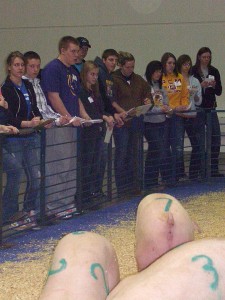By Christopher Squier
Grinnell High School student Matt Kriegel recently placed first in the Iowa Youth Swine Judging Contest, along with his GHS classmates, who took 5th, 13th and 16th place in team judging. The contest was held in Des Moines on Jan. 27, with over 400 participants.

Surprisingly, Kriegel doesn’t have very much background with swine or livestock judging.
“I don’t have a pig,” he admitted. “I’m actually the first person in my family that’s taken any sort of course in agriculture.”
Kriegel only recently started judging livestock at school as part of a class.
“We started by learning about the cattle industry, and how you judge different types of cattle,” he said. “Then we moved on to the swine industry and how you judge them based on certain placing factors.”
His teacher and coach in Agricultural Science, Ashley Wolfe, explained the curriculum.
“In this class, we learn about beef, swine and sheep, the main livestock on a farm. We have another trimester where we learn more about reproduction, genetics and anatomy,” she said.
The class provides the students an opportunity to learn about various forms of agriculture.
“I’m originally from Kansas,” Wolfe said. “And even there, the agriculture’s really different. We had cattle and wheat, and up here, it’s pigs and corn and beans.”
Livestock judging can help students earn scholarships, and additionally, it serves an important role in agriculture. Livestock judging is important in determining Expected Progeny Differences (EPDs).
“[EPDs] are, basically, selection factors for breeding stock,” Kriegel said. The most important aspect of training for Kreigel was simple practice.
“Good animals help, and having the definition of a good animal and a bad animal,” he said.
The rest of the skills required to judge livestock come from practicing with video judging and learning the standards and value of different characteristics.
“In here, we do video judging. There’s four animals, and they have them walk and stand,” Kriegel said. “You work from the ground up on the animal and then you go rear forward. You look at important placing factors first and then you pick your easy placements, like, ‘This animal’s really good, it has to go in first. This animal’s really bad, it has to go in last.’”
Criteria for determining good and bad animals depend on the class of animal. A pig can either be market class, meaning it’s raised for meat, or breeding class.
“If it’s a market class, you look at muscle first, and then you look at growth and volume, which is how long, how wide and how deep they are in the body Kriegel said. “Then you look at leanness, and you look from front to back at where fat is placed first.”
Structure is also important, especially the pasterns and back legs, which might have structural problems. Ultimately, a good market pig balances all these aspects to win, in the market class.
“[For breeding class,] the single most important factor is structure,” Kriegel clarified.
There are also different breeds of swine to consider. “Berkshire is the really meaty breed for swine, and Yorkshire is the mothering breed,” he said.
Kriegel managed to take first place partly due to his positive performance in the carcass evaluation. “That is the hardest part of the contest,” Wolfe said, “and he did really well.”
“[For] the carcass evaluation, you have to determine back fat and live weight and percent lean based on information they give you, and you have to base it on what you see from the other pigs,” Kriegel detailed.
“For some, they’ll give you a weight, and for another, they’ll give you the back fat they had. This one pig would weigh 270 pounds. That’s a pretty big pig, and then you look at another pig, and it’s really small, so you guess around 250 pounds.”
When asked if he would pursue a career in livestock judging or agriculture, Kreigel said, “I haven’t decided yet. My first thing I really want to do is criminal justice.”


















































blog.bitcomet.com • Feb 20, 2013 at 5:32 pm
I got this site from my pal who told me about this site and at the moment this time I am browsing this site and reading very informative
posts here.